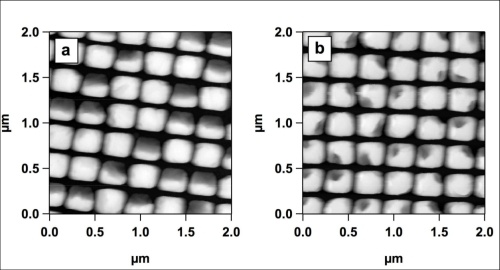New organic memory showed good potential
Those of us who have read a great deal with all sorts of screens (and thus does not have an unlimited supply of unkillable eagle vision), long known: with all the disadvantages of e-ink readers and related special they have no alternatives. Anything that is not E-Ink, sooner or later turns into teary eyes biomass. In a word, “better elektrobumagi no worse.”
Alas: expensive (compared to conventional tablet screens), and an update to the mass products is not very … Basically, there is a way to reduce the cost of serious electronic paper. It can be produced on organic, rather than silicon electronics, but so far all carbon-based devices such rested on the lack of an effective memory on organic ingredients.
Silicon in this memory can only substrate (black); polymers made from ferroelectric nanodots (blue) and semiconductive film surrounding the point (pink). Yellow and gray are shown electrodes. (Here and below illustration ACS Nano.)
And a group of European scientists led by Alain Jonas ( Alain M. Jonas ) of the Catholic University of Louvain (Belgium) announces the establishment of energy-efficient and capacious memory polymer based.
To achieve a stable storage, memory uses arrays of nanodots made on the basis of ferroelectric polymer polarization is changed by the application of voltage to the polymer, thus allowing to have a “1” instead of “0” and vice versa, that is carrying record-overwrite. These points are the developers call “segnetotochkami”, and read from the data they used thin films of polymeric semiconductors surrounding array of nanodots. The polarization direction of the ferroelectric polymers, determines how easy the current flows through the semiconductor film, thereby enabling stable reading.
Each of the 250-nm dots is separated from an adjacent gap 150 nm and consists of поливинилиденфторидаранфторэтилена; semiconductor film made of poly (3-hexyl) thiophene, filling the gaps between the nanodots. Only the upper electrode data storage device is made of metal (silver). Operating voltage is in the range of 1.5-2 V, which is comparable to the current memory performance. Novelty can now implement in RFID-devices , developers believe.
Array of nanodots “eyes” of the atomic force microscope.
All is good, but like the new memory with the main parameter – capacity? According to the researchers, the new segnetotochechnye drives have a capacity of 0.2 GB / cm ², and with a decrease in individual nanodots to 80 nm, it will only increase. Undoubtedly, this is serious enough performance to talk about the prospects for the implementation of certain organic memory in a variety of areas, including e-readers and a carbon-based.
Report on a study published in the journal ACS Nano.





